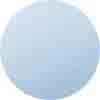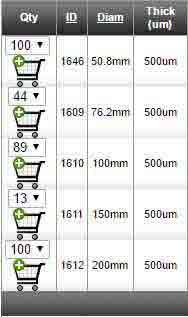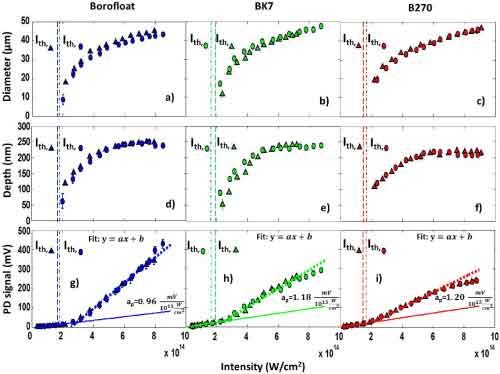BK7 Glass Wafers for Research & Production
What BK7 Glass Wafers Are Used in Research?
Bk7 glass is ideal for optical systems and is often used in a wide range of high-performance environments. BK7 unique properties makes the right kind of glass for sensitive electronics and medical devices.
of high-performance environments. BK7 unique properties makes the right kind of glass for sensitive electronics and medical devices.
A scientist at a large government lab requested the a quote for the following:
"I’m looking to order some custom 25mm diameter glass wafers. I’m using them as sacrificial plates during tests and I am not picky about optical performance or thickness. Looking to be transparent for visible. Insensitive to thickness, though thicker is better. BK7? Soda lime? Looking for price points at 100ea. and 200ea. How about 1mm thick?"
Reference #270300 for specs and pricing.
Get Your BK7 Glass Wafer Quote FAST!
Bk7 Glass Wafers
Tempered gorilla glass is one of the most used covers for mobile smart phones. It is strong, lightweight and most of all inexpensive. Critics argue that it is not nearly as strong as sapphire-currently used on Apple's Iwatch.
SCHOTT N-BK7 Glass Wafer Applications
N-BK7 is a borosilicate high-purity, clear optical glass with excellent optical quality, uniform transmission in the  visible range, and low inclusion content. This glass is ideal for a wide range of sensor and substrate applications, including photonic crystals, lasers, and semiconductors. UniversityWafer, Inc. Supplies various dimensions of BK7 that are in stock and ready to ship. Contact us to order custom-made SCHOTT N-BK7 glasses for your next project.
visible range, and low inclusion content. This glass is ideal for a wide range of sensor and substrate applications, including photonic crystals, lasers, and semiconductors. UniversityWafer, Inc. Supplies various dimensions of BK7 that are in stock and ready to ship. Contact us to order custom-made SCHOTT N-BK7 glasses for your next project.
Whether you're looking for a single or multi-layered glass wafer, you can find it at UniversityWafer, Inc. We offer many different sizes of Bk7 Glass windows. UniversityWafer, Inc. and our parnter fabricate the highest quality wafers.
Glass wafers are essential for many applications. Whether you need them for a sensor, optical lens, or other device, a borosilicate glass wafer has endless uses. It is a versatile material and can be made of a variety of specialty glass materials. Aside from high-quality bk7 glass, it also offers the same advantages of a silicon wafer. It is also used in many biotech and MEMS applications.
Other glass wafers include quartz and borosilicate. These materials have high-quality optical properties and are often used in semiconductor components. Besides these, BK7 glass wafers are also highly inexpensive. They can be fabricated into a variety of shapes and sizes, including custom-designed ones. They are also available in a wide range of thicknesses.
A wide variety of glass substrates is available in SEMI specifications. Fused Silica, Float glass, and Soda Lime Glass are just a few examples. These materials are used for semiconductor applications, and are extremely flexible and durable. For the most demanding of applications, they are particularly useful for optical devices.
What is BK7 Glass?
If you have ever wondered what is BK7 glass, you are not alone. Many people are confused about the different  types of glass. It is also known as Crown glass, Flint glass, and Opaque block glass. Read on to learn more. It is an optical glass with a low refractive index and low dispersion. It is made from a mixture of alkali-lime silicates and contains a small amount of potassium oxide. It is one of the oldest types of low dispersion glass.
types of glass. It is also known as Crown glass, Flint glass, and Opaque block glass. Read on to learn more. It is an optical glass with a low refractive index and low dispersion. It is made from a mixture of alkali-lime silicates and contains a small amount of potassium oxide. It is one of the oldest types of low dispersion glass.
N-BK7
N-BK7 is a high-purity borosilicate glass with small inclusions. Its refractive indices are homogeneous throughout the surface and make it an ideal choice for optics. In addition, this glass is softer than Zerodur and fused quartz, making it a more suitable choice for sensitive applications.
The unique properties of N-BK7 glass make it an ideal choice for optical systems and high-performance environments. Its properties make it a great choice for medical equipment, optical systems, and mobile smart phones. The material is lightweight and inexpensive. However, some critics say that it is not as robust as sapphire, which is the material used in Apple's Iwatch.
However, there are several challenges in manufacturing this material. For one, it requires the proper mold. Proper mold design is critical because it affects residual stresses, geometry distortion, and optical properties. This glass can change its refractive index after the molding process, and the right mold is essential for a successful manufacturing process.
Another challenge is the lack of a good model for N-BK7 glass. While Zemax can give an accurate approximation of the visible spectrum, it is not accurate enough and should not be used as a sole method. There are other, more accurate methods for glass modeling. Nevertheless, the model glass can be used to simulate optical properties of N-BK7 glass.
Crown glass
Crown glass is a type of borosilicate optical glass. It is colourless and virtually inclusion-free, making it an ideal optical glass for window and wafer applications. It transmits light in the visible and near IR ranges and is stable to carbonic acid action. This material is used for a variety of applications, including sensor technology, optical enclosures, and lenses.
Borosilicate Crown glass is one of the most common types of optical glass. It is made from alkali-lime silicates containing about 10% boric oxide. Its properties make it ideal for precision optics, mirror coatings, and dispersion prims. Crown glass is also resistant to scratch and chemical attack.
Crown glass is different from flint glasses in several ways. Its higher index of refraction makes it an ideal choice for prisms in high-end binoculars. It also features a round exit pupil. Crown glass is commonly used in precision lenses and it has excellent chemical stability. It requires no special handling.
Crown glass is a type of optical glass and window glass. Its refractive index is 1.52 and its dispersion is about 60. It contains about 10% boric oxide, which gives it excellent optical and mechanical characteristics. Crown glass is one of the oldest low-dispersion glasses.
Flint glass
Flint glass was named after flint nodules in chalk deposits in southeast England. They are excellent sources of high-purity silica. In the 18th century, George Ravenscroft used them to make potashlead glass, the predecessor of English lead crystal. In older flint glasses, there was usually about four percent lead(II) oxide present. However, the process of manufacture and disposal of the glass caused environmental problems. Therefore, most modern flint glass contains titanium dioxide or zirconium dioxide instead.
Crown glasses, flint glass, and borosilicate glasses are often used in optical instruments. Crown glasses have a relatively low Abbe number (50-60) and are used in making achromatic lenses. Flint glass is a harder type of glass with a higher refractive index than crown glass. It also has a higher dispersion index than crown glass.
Float and AR/Flint glasses are made by drawing glass over molten tin baths. After being drawn, it is further processed by chemically strengthening it. This makes it harder and more scratch-resistant. It can also be lapped, polished, and cut into a wide variety of shapes and surfaces.
Optical glasses are also produced with various additives. These can affect optical properties and wavelength. The most common types of optical glass are crown glass and flint glass. Flint glass has lead while crown glass has a higher level of potassium oxide. The chemical composition and additives will determine the specific optical properties of each type of glass.
BK7 is a high-quality optical glass. It is an excellent choice for a wide variety of applications. Its crystalline structure, low inclusion content, and excellent transmittance properties make it a suitable choice for optics. The BK7 glass is typically used in optical windows, lenses, prisms, and other optical devices that use the visible spectrum.
Opaque block glass
Opaque block glass is a versatile material used in a variety of applications. Its unique properties include light transmission and privacy, and it also has visual textures that give it a unique appearance. Besides being aesthetically appealing, it can also contribute to LEED certifications. It is highly durable and can be installed on horizontal and vertical surfaces.
Its thickness and texture vary greatly, and some are stamped with designs or patterns. It can also be used to customize a design by incorporating inserts. Typically, it is manufactured in accordance with International Standard ISO TC 160/SG1 and European Standard EN1052-2. Depending on the specification, it is classified in Class I, Class II, and Class III. The Class 1 rating is the highest and allows a maximum deviation of 1 mm.
Opaque blocks are a cost-effective way to bring in natural light into a space. They are durable, easy to clean, and impact-resistant. Glass-block walls can be incorporated into a room's design to create a more appealing aesthetic. Opaque block glass has the added benefit of being versatile - you can embed conventional windows into them, as well as turn and round corners.
Opaque block glass comes in a variety of thicknesses and designs. The standard 3-7/8-inch block offers the widest range of shapes, sizes, and patterns. It also offers good thermal insulation. Some manufacturers use adhesive to bond the two halves of a glass block, giving it a fire-resistant finish. Whether it is for a commercial project or a residential one, opaque block glass has the qualities you need.
If you're interested in purchasing glass blocks, Glass Block Warehouse carries an extensive selection. The company is a certified Seves Glass Block dealer and offers many patterns and metric styles. You can browse their extensive inventory and order online for the best price. If you need to find a glass block for your next project, Glass Block Warehouse is your best bet.
The two primary characteristics of glass block panels make them safe for use in buildings during earthquakes. These qualities make them relatively rigid compared to tall buildings and allow them to absorb earthquake-related motion very slowly. Additionally, the glass block panels' low vibration frequency makes them comparable to a car's soft shock absorber.
